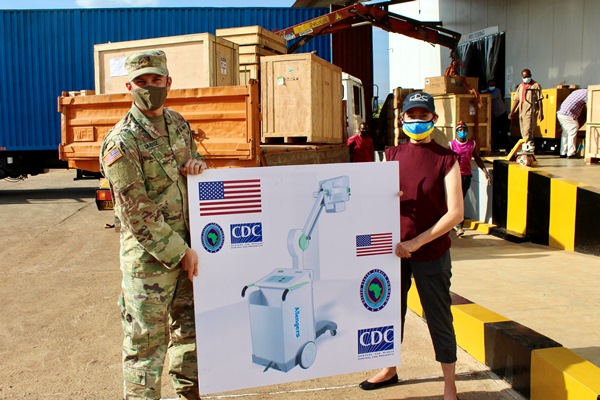
The United States of America delivered five new mobile X-ray machines to Rwanda Biomedical Centre today as part of the long-standing U.S. commitment to improving health in Rwanda. The X-ray machines provide urgent support to Rwanda’s ability to diagnose and treat COVID-19 patients as much of Africa battles a significant wave of cases.
“The United States and Rwanda are strong partners in public health,” said U.S. Embassy Kigali Charge d’Affaires, a.i. Deb MacLean. “By working together, we are saving lives every day.”
The five new mobile X-ray machines, valued at 220 million Rwandan francs, provide essential support to five current priority locations: Kanyinya Treatment Center, Kibungo Referral Hospital, Kinihira Treatment Center, Ruhengeri Referral Hospital, and University Teaching Hospital in Butare (CHUB). In addition to improving diagnosis of COVID-19 cases, the machines help the hospital diagnose other respiratory diseases and improve medical treatment at a patient’s bedside in real-time.
The new mobile X-ray machines are part of a series to be donated to COVID-19 ICUs across Rwanda. The first machine was delivered to Kibuye Referral Hospital in May 2021. The mobile X-ray machines are funded by the U.S. Department of Defense and come through the United States Africa Command (AFRICOM) and the United States Overseas Humanitarian, Disaster Assistance, and Civic Aid (U.S. OHDACA) program, a unique humanitarian assistance package that builds Rwanda’s effectiveness to prepare and respond to COVID-19.
The donations were coordinated by the U.S. Centers for Disease Control (U.S. CDC), which has played a leading role in supporting Rwanda’s ability to prevent, detect, and respond to COVID-19.
This U.S. donation is part of the more than 17 billion Rwandan francs the United States has invested in Rwanda’s COVID-19 response since March 2020.
This assistance includes the construction of hand-washing stations across Rwanda; public communications campaigns to fight COVID-19; staff and vehicles to for contact tracing; laboratory diagnostic equipment and supplies; training of frontline workers; medical equipment including ventilators, patient monitors, hospital beds, intensive care units, video laryngoscopes, and pulse oximeters; and infection prevention and control supplies such as biohazard bags, alcohol, soap, and personal protective equipment. (End)
